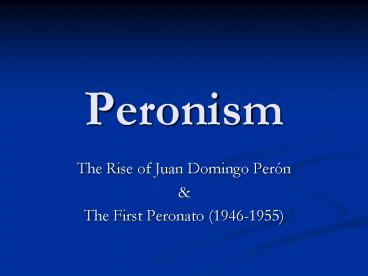Peronism - PowerPoint PPT Presentation
1 / 14
Title:
Peronism
Description:
Father's family originally from Italy and some had become ... Per n grew up in rural Buenos Aires and Patagonia. Had firm links with the Creole population ... – PowerPoint PPT presentation
Number of Views:290
Avg rating:3.0/5.0
Title: Peronism
1
Peronism
- The Rise of Juan Domingo Perón
- The First Peronato (1946-1955)
2
The Rise of Juan Domingo Perón
- Family Background
- Fathers family originally from Italy and some
had become important doctors in Argentina - Mothers family part Mapuche, part Spanish and
lived more humble lives - Perón grew up in rural Buenos Aires and Patagonia
- Had firm links with the Creole population
- Originally studied medicine, but then switched to
military after friends had entered the Colegio
Militar
3
The Rise of Juan Domingo Perón
- Early military experience
- Well known for athletic abilities, only adequate
student - Participated in early interventions in Santa Fe
in 1919 - At time discussed situation with labor leaders
- Had low level participation in 1930 Coup
- Originally sided with Uriburu, later withdrew
support and sided with Justo - Thought the masses would never accept
dictatorship (written in 1931) - 1931-36 assigned to teach at Escuela Superior de
Guerra, had married Aurelia Tizón in 1929 died
1938
4
The Rise of Juan Domingo Perón
- Early military experience
- 1936-38 served on the border with Chile
- Then sent to Germany for advanced training,
1938-40 - 1941 sent back to Mendoza led to friendship
with Edelmiro Farrell, one of the main
conspirators in 1943 coup - Involvement in Coup of 1943
- Helped form GOU, Grupo Obra de Unificación
- Was rewarded with the Secretariat of Labor, Oct.
1943 during Presidency of Pedro Ramírez who
lasted only until Feb. 1944 replaced by VP,
General Farrell
5
The Rise of Juan Domingo Perón
- Involvement in Coup of 1943
- Began to get workers out of jail
- Insisted on more social and economic benefits
- Created the aguinaldo
- By 1945 Perón had 3 positions
- Minister of Labor and Social Welfare
- Minister of War
- Vice President
- Forced by opponents to resign, Oct. 9, 1945
- Returned in triumph to Bs As on Oct. 17
- Resigned from army Oct. 18 and declared himself
candidate for president for the Feb. 1946
elections
6
The Rise of Juan Domingo Perón
- 1946 Elections
- Perón created two parties
- a labor party
- the other a segment of the Radical party
- His VP was Hortensio Quijano, a Radical
- Political platform
- Shorter working hours
- Labor participation in corporate profits
- Political rights for women
- Perón and the Church
- Married Eva Duarte de Perón to get Church support
- Worked with clergy to get Nov. 1945 pastoral
letter to vote against candidates in favor of
legal divorce, secular education, separation of
Church and state
7
Perón as Gardel
8
Carlos Gardel
9
The First Peronato (1946-1955)
- Economic Policies
- New role for labor
- Basic ally of Partido Laborista, Justicialista
- More people unionized than ever before
- Included bankers, traveling salesmen, domestic
servants and rural workers - Granted personería gremial to unions that
supported him - Right to represent workers in court
- Favorable contract negotiations allowed workers
to increase real wages (38-46 of GNP) - Changed the nature of the CGT Confederation of
Labor - Leadership initially hostile to Perón
- Replaced with pro-Peronist leaders
- Traditional historiography of labor history
10
The First Peronato (1946-1955)
- Economic Policies
- Increased importance of economic nationalism
- Roca-Runciman act had provoked strong criticism
- War time profits enabled Perón to eliminate
national debt and propose expropriation of
foreign companies - Decline of economic independence in Tucumán, July
9, 1947 - Took up old idea of nationalizing railroads long
after some lines had offered to sell to the
Argentine government - Reduced foreign investment in Argentina by 40 by
1955, but at what cost? - Deterioration of agriculture role of IAPI
- Emphasis on consumer industry, inefficient
- Problems with heavy industry
- The end of the Peronist boom, 1952-1955
inflation, stagnation
11
Evita lying in state
12
The First Peronato (1946-1955)
- Social Policies
- The role of the descamisados the shirtless
ones - Growth of internal migration 1920s onward
- Were the descamisados Perón main strength?
- Women and Peronism
- 1947 Female suffrage law reaction of feminists
- Womens Peronist Party, Partido Peronista
Feminista - Children and the Peronist revolution Children
are the only privileged group in Argentina - Series of new laws to eliminate stigmas towards
children - Adoption, end of illegitimacy
13
Eva and Juan in 1952
14
The First Peronato (1946-1955)
- Social Policies
- Children and the Peronist revolution Children
are the only privileged group in Argentina - Work of Eva Perón Foundation (1948-52) after the
demise of the Sociedad de Beneficencia - Construction of childrens schools, hospitals,
vacation spots, orphanages - Created an entire miniature city for children
- Other reform laws
- Passage of Divorce Law, 1954
- Legally reopened houses of prostitution, Dec.
1954 - Perón and the Catholic Church
- The overthrow of Perón, 1955































